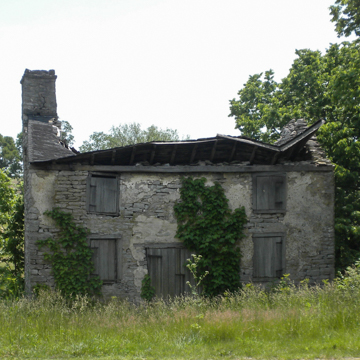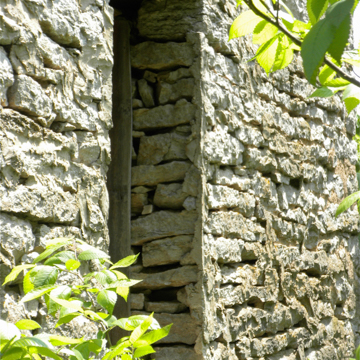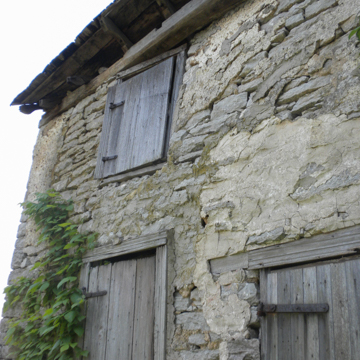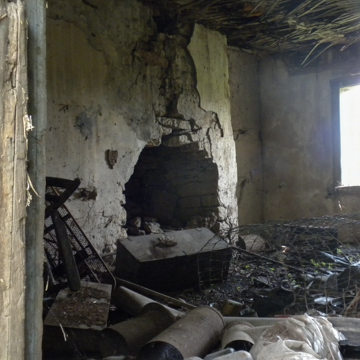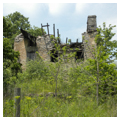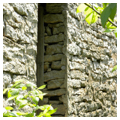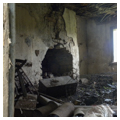You are here
Choctaw Indian Academy
In April 2016, disaster struck the only remaining building from the Choctaw Indian Academy when its shake roof collapsed. This imperiled, three-story fieldstone structure served as a dormitory for men who were being schooled at the only federally funded academy for Native Americans pre-dating the Indian Removal Act of 1830.
Four stone buildings and one frame building originally stood on a bluff overlooking the spring creek on then State Representative Richard Mentor Johnson’s Blue Spring Farm, some five miles west of Georgetown. Most of the buildings dated to 1825, when the Choctaw and the United States government came to an agreement that $6,000 a year should be allocated for a period of twenty years towards the education of Choctaw children. Other Native American tribes began to send their sons to Georgetown and thus at its peak, some 200 students including Creek, Chickasaw, Miami, Osage, and Potawatomi attended the Choctaw Indian Academy. Local boys were also educated at the Academy.
The surviving fieldstone structure is built into the hillside and is three stories high on the south side and two stories on the north. It is approximately twenty-seven feet wide by twenty feet deep and was originally coated in lime plaster both inside and out. Window openings are timber framed and shuttered and presumably were glazed originally. The shake roof was supported by ample rafters and had an underlayer of wattle or reed. The massive stone fireplaces that occupy the eastern wall of each floor provided heat during Kentucky’s bitter winters. Other buildings at the Academy are described as larger, including the two-story stone house that was forty-four feet long by twenty-four feet wide; this dormitory was divided into two equally sized rooms on each floor, possessed four windows with twenty panes each, and accommodated 100-120 students. At least one of the stone houses had a Franklin stove. The frame house was considered appropriate for a family as it had its own garden and outhouse; its foundations lie under a mid-twentieth-century Cape Cod Revival house.
Known as the “hero of the Battle of the Thames,” Johnson may have been involved in such a radical project due to his brother-in-law, William Ward, who was Agent for the Choctaw Nation. The Reverend Thomas Henderson provided tutelage to the boys in rooms that were said to be well furnished with maps, globes, and books; clothing was also provided. On Sundays, the boys attended religious services, presumably at the Great Crossing Baptist Church some two-and-a-half miles down the road alongside the North Elkhorn Creek. It is worth noting that the names “Great Crossing” and “Stamping Ground” allude to an ancient buffalo trace or pathway.
In 1831, Johnson relocated the Academy to his White Sulphur Springs Farm, where he also ran a fashionable watering resort. A trade or vocational school was added at this second site and the Lancasterian system, by which older students instructed younger ones, was introduced. The Choctaw Indian Academy remained open until 1843, well after the Indian Removal Act of 1830 and the subsequent forced displacement of Native Americans from Kentucky and surrounding states. After the Academy closed, the buildings were adapted to farm use.
While the sole surviving building is in deplorable condition and is not visible from the road, the existence of the Choctaw Indian Academy is a facet of American and Kentucky history that should not be forgotten.
References
Gaines, Mrs. Joe, “Choctaw Indian Academy,” Scott County, Kentucky. National Register of Historic Places Inventory–Nomination Form, 1972. National Park Service. U.S. Department of the Interior, Washington, D.C.
Foreman, Carolyn Thomas. “The Choctaw Academy.” Chronicles of Oklahoma6, no. 4 (December 1928).
Writing Credits
If SAH Archipedia has been useful to you, please consider supporting it.
SAH Archipedia tells the story of the United States through its buildings, landscapes, and cities. This freely available resource empowers the public with authoritative knowledge that deepens their understanding and appreciation of the built environment. But the Society of Architectural Historians, which created SAH Archipedia with University of Virginia Press, needs your support to maintain the high-caliber research, writing, photography, cartography, editing, design, and programming that make SAH Archipedia a trusted online resource available to all who value the history of place, heritage tourism, and learning.














